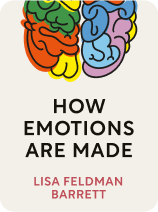

This article is an excerpt from the Shortform book guide to "How Emotions Are Made" by Lisa Feldman Barrett. Shortform has the world's best summaries and analyses of books you should be reading.
Like this article? Sign up for a free trial here.
What is the interoceptive sense, according to psychology? Why is your interoceptive sense important? How can you strengthen it?
The interoceptive sense is a powerful tool for understanding and coping with your own and others’ emotions, according to neuroscientist and psychologist Lisa Feldman Barrett. Barrett believes this little-known sense impacts your mental wellbeing more than most people realize.
Read on for Barrett’s definition of the interoceptive sense, including why it’s important to strengthen it.
What Is Your Interoceptive Sense?
Even though emotions are not the same across cultures, Barrett says that basic internal feelings on a spectrum from pleasure and displeasure and calmness to agitation are universal. These feelings are essentially summaries of your body’s inner state (they’re also called affect). They’re part of an internal process called interoception.
In interoception, your brain gets sensory input from inside your body, including information about your heart rate, breathing, blood pressure, temperature, hormones, metabolism, and so on. Then, in a process that Barrett dubs “body budgeting,” your brain makes predictions about what those internal sensations mean in terms of your body’s energy needs, and it regulates the body accordingly—by doing things such as speeding up your heart, slowing down breathing, releasing more cortisol, or metabolizing more glucose.
The Interoceptive Sense in the Brain
Using your interoceptive sense is a whole-brain process. This means that the brain is structured so that all of your decisions and actions, no matter how much you believe them to be rooted in logic and reason, are affected by your inner feelings.
(Shortform note: It’s theorized that children with sensory processing issues struggle with interoception—they may have difficulty recognizing that their bladder is full or deciphering between itchiness and pain. In addition to not recognizing physical sensations in their bodies, they can also have trouble connecting with emotions. For example, a child may not feel fear because she isn’t noticing the internal physical characteristics that are associated with fear, such as a racing heart.)
In addition, your brain is wired to listen to your internal sensory input more than it listens to external sensory input. Contrary to the popular belief that the things we see, hear, and smell influence what we feel, Barrett claims that the way we feel inside is more influential to perception and action than the outside world is.
The Power of Your Interoceptive Sense
As an example of the power of unanalyzed internal sensations, Barrett cites an experiment that found judges were more likely to deny inmates parole before lunch. Once the judges had eaten lunch, they began granting parole with their normal frequency. The judges had experienced a “bad” feeling in their gut as evidence that the inmates didn’t deserve to be paroled, rather than evidence that the judges were simply hungry. (Shortform note: As detailed in Noise, this type of unintentional bias can have life-changing consequences. Perhaps with more awareness of our internal sensations (and their effect on our emotions) we can avoid bias like this in the future.)
You constantly use your interoceptive sense. It usually produces simple “good” and “bad” feelings, but sometimes you experience moments of intense interoceptive sensations as emotion. For example, on some days you may experience a vague sense of agitation and displeasure, but on other days and in other contexts, those feelings may become so intense as to manifest as anger.
(Shortform note: The vagus nerve is central to the interoceptive sense. The vagus nerve is one of the main cranial nerves conveying information to and from the brain through the body’s sensory pathways. It is one of the longest and most widely distributed nerves in the human body (vagus means wandering in Latin). The way the vagus nerve works tends to demonstrate that the body’s inner sensations have more impact on the brain than the other way around: 80% of fibers in the vagus nerve ascend from organs such as the stomach and the heart to the brain, while only 20% descend in the reverse direction.)

———End of Preview———
Like what you just read? Read the rest of the world's best book summary and analysis of Lisa Feldman Barrett's "How Emotions Are Made" at Shortform.
Here's what you'll find in our full How Emotions Are Made summary:
- A deep dive into what emotions really are and where they come from
- How some cultures have different emotions than others
- The difference between feelings and emotions






